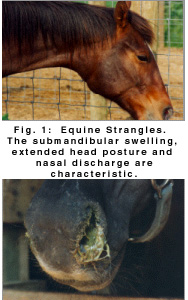 INDUCTION OF MUCOSAL AND SYSTEMIC ANTIBODY SPECIFIC FOR SeMF3 OF STREPTOCOCCUS EQUI BY INTRANASAL VACCINATION USING A SUCROSE ACETATE ISOBUTYRATE BASED DELIVERY SYSTEM
INDUCTION OF MUCOSAL AND SYSTEMIC ANTIBODY SPECIFIC FOR SeMF3 OF STREPTOCOCCUS EQUI BY INTRANASAL VACCINATION USING A SUCROSE ACETATE ISOBUTYRATE BASED DELIVERY SYSTEM
J. Nally, S. Artiushin, A. Sheoran & J.Timoney
Gluck Equine Research. Center,
University of Kentucky, Lexington, KY 40506
P. J. Burns, B. Simon and R. Gilley
Thorn BioScience LLC
Lexington, KY 40523
J. Gibson and S. Sullivan
Southern BioSystems, Inc.
Birmingham, AL
ABSTRACT
Streptococcus equi causes equine strangles, a highly contagious disease of the upper respiratory tract. A 58 kD acid and heat resistant M-like protein (SeM) is an important virulence factor and protective antigen. Resistance to reinfection in convalescing horses appears to be more strongly associated with SeM-specific IgG and IgA in the nasopharyngeal mucus than with opsonic antibody in serum. Administration of an immunogenic peptide of SeM (SeMF3) intranasally by itself stimulates a limited mucosal response. Sucrose Acetate isobutyrate (SAIB) is a high viscosity excipient that provides controlled release of biologically active substances. The potential of SAIB as a delivery system for intranasal immunization of horses with an immunogenic region of SeM was investigated in the present study. A vaccine was prepared in which SAIB was dissolved in 25% ethanol and recombinant SeMF3 added to a final concentration of 100ug/ml using dimethyl sulfoxide as a solvent. Two mls of vaccine were administered intranasally to each of 11 adult mares using a soft catheter on day 0 and 28. Nasal washes and serum samples were taken on day 0 and at 2 week intervals. SeMF3-specific IgG and IgA responses were assayed by ELISA. Six mares showed an increase in serum IgG antibody. Nine showed mucosal responses similar to those observed in convalescent horses. A booster response occurred after the second vaccination. These results suggest that SAIB has potential as a vehicle for intranasal immunization of horses with antigenic peptides.
CONCLUSIONS
No adverse affects were observed following intranasal immunization with SAIB Intranasal immunization with SeMF3 stimulates a nasal IgA response only Intranasal immunization with SeMF3 combined with SAIB stimulates both nasal and systemic IgA, IgGa, IgGb and IgGT. A booster response occurred after the second vaccination Serum antibodies of immunized horses recognize linear epitopes of the SeMF3 molecule SAIB is an effective system for the intranasal delivery of antigenic peptides to the equine nasopharyngeal mucosa to induce specific serum and mucosal antibodies
AKNOWLEGEMENTS
J.Nally is supported by a Maxwell and Muriel Gluck Fellowship in equine studies. We thank Dr. Chris Stokes, Bristol Veterinary School, Bristol, England for his generous gift of mouse anti-horse IgA monoclonal antibody, and the mares of Ashford stud for their willing cooperation.
REFERENCES
Boschwitz, J.S. and Timoney, J.F. 1994. Inhibition of C3 deposition of Streptococcus equi subsp. equi by M protein: a mechanism for survival in equine blood. Infect. Immun. 62:3515-5520
Galan, J.E. and Timoney, J.F. 1985. Mucosal and nasopharyngeal responses of horses to protein antigens of Streptococcus equi. Infect. Immun. 47(3): 623-628
Nesch, Beatrice. Epizootiological, clinical and immunological features of an experimentally induced strangles epidemic. Doctoral Dissertation, University Freien, Berlin.
Sheoran, A.S., Sponseller, B.T., Holmes, M.A. and Timoney, J.F. 1997. Serum and mucosal antibody isotype responses to M-like protein (SeM) of Streptococcus equi in convalescent and vaccinated horses. Vet. Immunol. Immunopath. 59:239-251
Timoney, J.F., Artiushin, S. and Wang, J. Regions of the SeM protein of Streptococcus equi recognized by serum and mucosal antibodies of convalescent serum. Equine Infectious Disease VIII. In Press.
Timoney, J.F., Artiushin, S. and Boschwitz, J.S. 1997. Comparisons of the sequences and functions of Streptococcus equi M-Like proteins SeM and SzPSe. Infect. Immun. 65(9): 3600-3605
